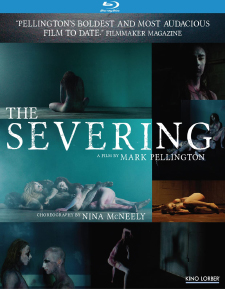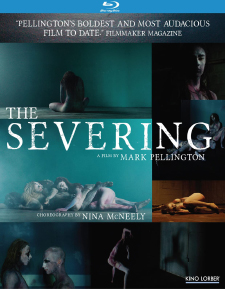Severing, The (Blu-ray Review)

Director
Mark PellingtonRelease Date(s)
2022 (June 6, 2023)Studio(s)
Kino Lorber- Film/Program Grade: C
- Video Grade: B-
- Audio Grade: A-
- Extras Grade: B-
Review
The Severing is a story told entirely through dance. Without a clearly defined plot, dialogue and character development, the film defies traditional narrative in favor of experimental choreography.
The dancers, wearing scanty costumes and covered in body paint simulating blood, bruises, and dirt, convey the sense that they are naked and abused. In a spare set that resembles a prison, they writhe, convulse, jerk, and freeze to Pete Adams’ otherworldly music.
The movements are not typical dance moves but odd combinations of what appear to be seizures and acrobatics. In some instances, the dancers arrange their bodies in configurations reminiscent of the dance theater group Pilobolus. The only verbal clue as to what the dancers are trying to project is inter titles that pop up on screen from time to time, but even these are largely enigmatic. “Self thought,” “I am the extraction,” “Residue and the tangible,” and “While someone is talking about love” are examples.
Music, costuming, lighting, and set design combine with the dancers to create a dark and fearsome mood. The dancers express with their bodies in primal fashion various feelings related to grief—longing, hope, loss, despair, love, reconciliation, and acceptance. Many viewers may find a 70-minute exploration of these emotions entirely through mood and movement a bit heavy. The work is clearly experimental, and dance aficionados might find the choreography—a combination of ballet and contemporary with generous helpings of acrobatics and mime—off-centered and alien.
Director Mark Pellington (The Mothman Prophecies) tests the viewer’s patience with long, lingering shots in which there’s barely any movement. If the goal is to create drama or suspense, the approach fails. In one lengthy shot, the camera shows a dancer’s immobile arm in the foreground with another dancer, hunched and blurry, in the background. The background figure eventually comes into sharp focus, but there is no reason, dramatically, for this. The set is intentionally grim. Bright lights and bold color would certainly have undermined the somber atmosphere the work requires. One extremely annoying choice is the flickering of light so that we can’t see the continuous movement of the dancers.
The inter titles are formed in unusual patterns and type styles and stay on screen for a very short time. This makes them difficult to read. The dancers are talented artists that form an ensemble with no single dancer standing out. At one point, a male narrator utters the phrase, “Where do I go when I fall asleep?” leading to dreamlike images and smoke machine effects. Occasional projections offer some relief from the stark, barren background. When seen in close-up, the dancers have death-like, blank stares, adding to the bleak mood.
The Severing was captured by director of photography Evelin Van Rei digitally with Arri Alexa Mini cameras and presented in the aspect ratio of 1.33:1. The look of the film is somber, dark, and sad, in keeping with its theme. Shots are very long, with dancers’ motions often barely perceptible. The setting is a bare, closed room with stained walls and dirty floors. Deep shadows fall on the dancers, further darkening the mood. Periodically, the screen goes completely black, creating a kind of slow-motion strobe effect. The camera sometimes moves around the dancers in continuous shots. Flashing, indistinct images on the wall flicker faintly behind the dancers in one sequence.
The soundtrack is English 2.0 DTS-HD Master Audio. Optional English SDH subtitles are available. The music is eerie and non-melodic, contributing to a dreamlike or nightmarish feel. Atonal sounds combine with Peter Adams’ minimalist score to complement the images and allow them to dominate. Occasionally, a narrator’s voice is heard.
Bonus materials on the Region A Blu-ray release from Kino Lorber include the following:
- Audio Commentary by Mark Pellington, Sergio Pinheiro, Peter G. Adams, and Lin McNeely
- Stills Gallery (2:35)
- Manifest Reality Music Video (5:22)
- Trailer (2:09)
Audio Commentary – The filmmakers discuss the genesis of the dance film, described as an exploration of grief and how it relates to the body. The work features almost still images with just a quiver of movement in some scenes. After director Mark Pellington contacted choreographer Nina McNeely about the project she selected dancers from Los Angeles who could perform without rehearsals. A few dancers were brought in at a time. McNeely gave a few prompts, then had the dancers improvise according to the emotion required. The original sound was atonal, dark, and non-melodic. Pellington asked Peter Adams to write a score with “heart and strength.” Adams had to decide how busy or sparse the music should be. He kept some of the original ambient tones, interweaving them with his new music. The last segment is a 14-minute, one-shot sequence. The entire film was shot in one day.
Stills Gallery – Behind-the-scenes footage is shown in color photographs, and provides an appreciation of the effort that went into the making of this dance film.
Manifest Reality – Featuring a performance by the band Sacred Reich, this music video contains moments from The Severing, with quick cuts of dancers in spasmodic positions, painted bodies, distorted faces, and disorienting images.
The Severing is a disturbing art film that blends various elements to create a feeling of loneliness, detachment, sorrow, and the pain of loss. Dance on film has always had its problems because a three-dimensional art is reduced to two dimensions. In a theater, the work might be more compelling, but on screen, The Severing lumbers along and its consistent gloominess eventually takes its toll on the viewer. This is not a film for those seeking an uplifting dance experience.
- Dennis Seuling

